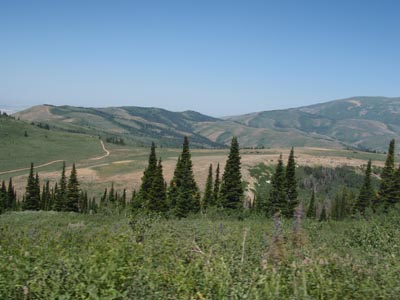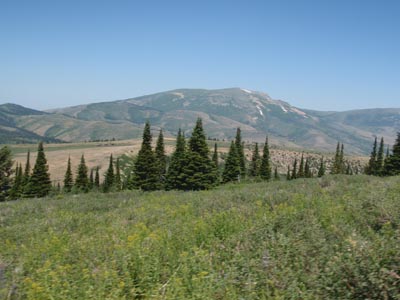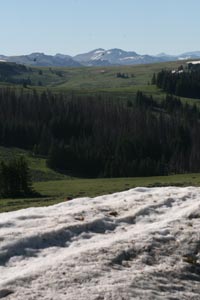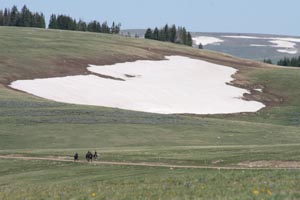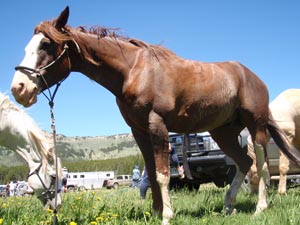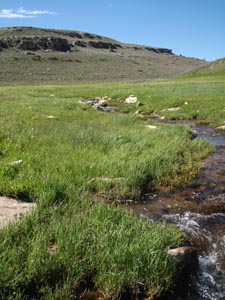
Friday July 22 2011
We'd sort of gotten the directions to Vet Check 3... but we crossed a creek we weren't supposed to cross, and as the old logging road got windier and narrower as it went up and up, we thought this couldn't be right. "Look for the porta-potty, at the 50's vet check" we'd been told... but - way up here?
We crossed the Big Horn trail markers a couple of times, but that could have meant we were on the right road, or totally the wrong road. We were just about to turn around and go back down... somewhere, to find someone to ask (no cell phone coverage anywhere), when we happened upon a portapotty and the 50's vet check, where people still happened to be waiting.
"Keep going!" they waved us on. "It's just a couple miles. Pass the Snowshoe Lodge, pass over a cattle guard, you'll see flags turning you off to the right."
Hooray, we find all this, and then... nothing. We come to a gate with an unlocked lock on it and a sign that says "Private Property." Another crew guy is there in his pickup. "Do we go through this?" Heck, we didn't know. We both drove through and closed the gate behind us. The road deteriorated - thank goodness it wasn't wet or we might be stuck up here a couple of weeks - and we came to ANOTHER gate. This
couldn't be right, we thought, and how much worse was the road going to get?
Just about when we were going to turn around and backtrack, we came around a corner to a beautiful mountain meadow busting with flowers and a meandering creek - and a portapotty, and Bill, Bev's crew husband and another truck or two. Yay, we'd found the vet check!

Some lucky humans also had a mountain hideaway tucked there at the end of the meadow (later they came over to visit, and much later they would assist some lost and tired riders and horses).
Then came... the waiting. The waiting is the hardest part. The boys had left Vet Check 2 at around 12:30; notwithstanding the "21" miles this section between vet checks 2 and 3 was supposed to be, we knew it would be much more (Tim French later confirmed it was 31 or 32, and our boys GPS'd it at 34 miles), and we were hoping to see them around 8:30 PM or so. We hoped. What to do for hours and hours? It only took so long to unpack the truck with the human and horse food and gear.
I worked on my computer a bit, I tried reading, and I dozed off in a chair. Then: I ate, Oh, my God, did I eat. Joe Haeberle's parents, Yvette and John, took it upon themselves to
cook food in Dutch ovens for everybody, right there at the vet check. I've had some good food and treats at endurance rides, but this was the ultimate. Fresh-out-of-the-oven wicked chicken fajitas (salad, and dressing on the side, too). If that was not most satisfying, they topped it off with
killer peach cobbler topped with whipped cream. I thought I'd died and gone to heaven. I ate so much I got close to nirvana. They made another oven-full of peach cobbler but I had to stay away, though they tried to tempt me again.

Then to top that off, I made some coffee with my camp stove and French press, with the extra coffee grounds that Tim French had leftover (ground fresh!) from this morning. Steph and I had our fresh, strong coffee, and lounged around waiting. I was really getting the hang of this crewing thing. Bad Tevis memories were fading. This crewing gig was not such a bad thing.

Since we still had hours more to wait, and I was in the serious Over-Done-It-Food stage, I went for a hike up the trail, a little stroll in the Big Horn mountains.

Along the old logging road, I surprised and met a deer and a grouse among the lodgepole pines, and wondered about cougars and bears, as I always do. There were moose in this mountain range too - Steph and I would see one of these magical beasts as we were driving out in the dark.

I trudged up an incline (difficult after a satiating meal!) and came out to a terrific view of the next valley, and thought of how it goes on and on - the Big Horn mountain range runs about 200 miles on a northwest/southeast line. It's something Kevin will mention at this vet check - "You go over one ridge, and the view is beautiful. You go over the next ridge, and the view is even more beautiful - after beautiful, after beautiful..."

I kept thinking I'll see the leaders Bev Gray and Kerry Greear in the distance in the valley, but I didn't. I turned around to hike back to camp where people were still waiting.
It was around 7:30 PM when someone said "There they are!" A glimpse of something moving in the trees - a closer look proved it to be a gray horse and a pinto - and the yeehawing confirmed that the first two riders were coming into the vet check. We all echoed their hoots and hollers as they trotted down the road and came into view, then stopped to let their very thirsty horses drink out of the creek.

Bev's horse looked great, as did Kerry's. Bev said the trail had been marked great. At the same time, we heard that all the 50 milers were off trail and overtime (the same trail the 100's were riding in reverse).
The hold was half an hour, and the sun was just sinking behind the hill as Bev and Kerry trotted out onto the trail for their last piece of trail ("25 miles" or so), and the next bunch came in - Andy and Brandon Bown, Bill Brown (it was Bill and his horse's first 100), and another guy whose name I didn't know. Brandon was looking pretty wiped out. Somebody get that boy a bottle of water!
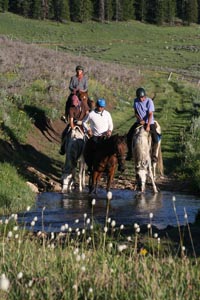
I made another French pressed pot of coffee that was waiting for Kevin, Kevin and Rusty when they arrived at the vet check, right around 8:30 PM. "That section was long! And hard!" But, they'd expected it. I grabbed their GPS's and plugged them into the truck to charge for half an hour. The horses still looked good after around 73 miles (by GPS), and they ate and ate and ate.
The horses already had glowsticks on the breast collars, which were broken so they'd light up. The boys duct taped headlamps to their helmets, and reloaded on water and ibuprofen. Kevin M's ankle was stiffening up a bit - he and Far had taken a tumble a week before the Big Horn. Far was fine, but Kevin had bruised his hip and sprained his ankle, and it was making some noise now.
With the sinking of the sun, it cooled down quickly with the brisk breeze; it was hard to decide what to wear for the two dozen miles of trail, which would probably take 5-6 hours. It would be hot down on the valley floor, but in the wilderness, you really don't want to be stuck without extra clothing.
The half hour blew by quickly and soon the boys were mounted up and headed out of the vet check. "See you at Trapper Creek," we said - a meeting place down on the valley floor about 7 miles (or thereabouts, nobody was sure) from camp. It was totally voluntary, but coming out of the mountains (we heard from last year's veterans), the horses are in need of water and grateful for hay, and humans are grateful beyond words for water or other pick-me-ups for the last miles into camp. The moon would be up soon, so they'd have some of Mother Nature's light to help them along their way.
Steph and I packed up the pickup and headed out. Five riders - the Stalleys and Lisa Schneider - were still out, but they should have been coming in soon, as they had been less than an hour behind our boys coming into the last vet check.

One rider had been pulled here... in the fading light we wondered how long she'd be out here waiting for a ride for her horse. It didn't appear easy to get a trailer in here, and there wasn't one on the way (we never did see one, on our 90 minute drive back to camp). On the way out, we saw a moose!!!!
Just going back to camp and crawling into bed was soooooooooooo tempting, but we just couldn't not meet our boys at Trapper Creek. We didn't have great directions to this stop either, but we stumbled along a road at the base of the mountains - and were startled when we came across Bev and Kerry on their horses! We hadn't seen any markers on this road, but figured Bev and Kerry knew what they were doing. (Not long after, we heard someone drove after them to get them and turn them around - they'd missed their turn off of this road.)
We weren't sure where to stop ("near the river" but we couldn't see the river). We spotted a parked pickup, and at first we weren't sure it wasn't some local Shell teenagers' make-out spot, until the Haeberle's rolled down their window and said we were at the right spot.
Steph stayed in the truck to rest her eyes (and consequently passed out for a while) and I pulled up a chair and yakked with the Haeberles. We talked of tall Big Horn tales, mainly of Joe's experience in last year's fiasco what with the storm, unmarked trail, people getting sick or disoriented and Joe's being passed off to different sponsors as he came down off the mountain. And he wanted to do it again! So far, he was having a good ride, and when he got down to this impromptu stop, while his horse guzzled water, Jose was busy taking photos of the moonlit bluff soaring over our heads.
Teresa from Tennessee also joined us - she had come all this way to crew for her friend Roxy Welling and the Colombians. One of the boys was pulled at vet check 2, but the other boy and girl were still riding with Roxy. Teresa had had a hard time finding vet check 3 in her truck because she hadn't had anyone to follow and didn't have a map (because one didn't exist) and the road to the vet check just wasn't marked. You had to know who to ask (or just get lucky), and when, to get where you needed to go.
The one thing Steph and I were did not have in the otherwise full truck was horse water; fortunately the Haeberles left us plenty of buckets full of water, and Theresa had some extra water too. The Haeberles left after Joe, and Teresa and I sat out in the pleasant moonlit night, watching and waiting for horses and riders to come off the mountain, talking a bit, spacing out a bit, trying not to fall asleep. We saw some lights coming... but it was somebody in a car, stopping to set out those flashers marking the trail for the riders - either this hadn't gotten marked yet, or the markers had been pulled and somebody was re-marking the trail, or they were adding to whatever markings that were there.
We called over any riders or horses that were passing near; every horse guzzled water and ate some hay we'd thrown out. Everybody spent a few to ten minutes here letting their horses eat and rest.
Steph came out of the truck in a short-nap-too-little-sleep torpor, just as our boys came down off the mountain around 12:30 AM, and we called them over for refreshments. They said that part of the trail was LONG and SLOW, and everybody looked tired - but still good.
It was about 7 miles or so in from here; 90 minutes or so by trail into camp. All I could think about was falling into my bed; I was pretty whooped. All I did today was eat, drink, wait, and wait some more (on little sleep the past 2 nights) and all I wanted to do now was balance that all out with sleep. I tried to tell myself that I wasn't riding, so I couldn't
possibly be as tired as our riders, or their horses, but it wasn't working. I was a wimp.
Back at base camp we let the dogs out of the trailer for a run and a break, set up the horses with hay, grain, and water, and corralled the dogs back in the trailer - and I am almost ashamed (but not really) to admit I could not make myself stay up for the boys' finish, which came about an hour later at 2:30 AM. We figured they'd finish, they
had to finish after that grand effort. So we'd see them in the morning when the sun was up.
Overall, I thought I'd redeemed myself crewing (except for the forgotten Starbucks vet check, which Tim French saved with his fresh coffee makings at that vet check, then giving us grounds for the last vet check), it was a perfect day in some spectacular mountains, our horses did great and we had fun. I was glad I didn't ride... and I had a great time.
I passed out in my bed before my head hit my fluffy pillow.














